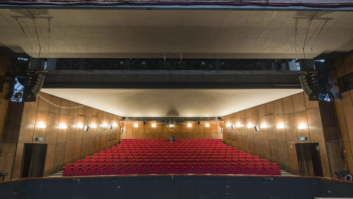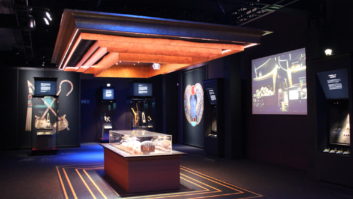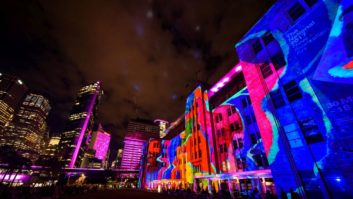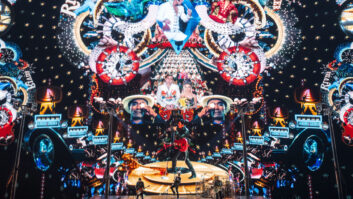When budget is no object, the client clearly expects the best. E-LIFEís Joanne Forster tells George Cole how those expectations were met.
There are some installations that simply have the wow factor, and this install carried out by E-LIFE in a Georgian-style mansion certainly has it. E-LIFE is based in Gateshead, in north east England, and the company offers a wide range of custom install services that cover music, lighting, heating, cinema, ventilation, security and more.
The mansion featured here includes five bedrooms, guest annexe and a bar, and is located in an affluent neighbourhood in the North East. It is a striking building, with a long sweeping drive, summer house and its own swimming pool.
E-LIFE won the commission through word of mouth: ìIt came from a previous project and thatís important, because being a small company, we donít have a massive marketing budget,î says Joanne Forster, E-LIFEís sales and marketing manager.
The first step was to meet the client and discuss a brief. The project was managed by E-LIFEís head engineer Paul Kinghorn and managing director Kevin Clayton was also heavily involved in the project.
ìThe initial briefing is crucialî, says Forster, ìand with this client, it was a pretty open brief.î The key, she adds, is to talk to the client and to listen. ìYou have to find out things about their lifestyle ñ how do you want the house to be used? Do you have lots of visitors? How flexible do you want the home system to be?î
Matching the lifestyle
The idea is to install a system that fits with the clientís lifestyle, rather than produce a system that the client must adapt to: ìYou obviously need to make the client aware of the possibilities, but you mustnít overwhelm them,î says Forster, ìA good install is not about designing a system which shows how clever your engineers are, but one that delivers what your client wants.
ìItís one thing to create a sophisticated install for a demonstration room and quite another to produce one for someoneís home. You have to remember that people have got to live with the system in their home day-in and day-out, and if it doesnít meet their needs, then you have failed, no matter how advanced the system is.î
In the case of this particular install, there were other factors to consider as well. First, it was important that the system enhanced the homeís artwork and interior design. Second, it had to complement a sophisticated lighting system that was being installed by lighting design company Park Lighting.
ìItís a very luxurious lighting system that includes a waterfall in the entrance that is illuminated by lights placed in the water,î says Forster. As far as this install went, E-LIFE was fortunate for two main reasons, she suggests: ìThe first was that the client was great to work with, He was very open to ideas and we felt very comfortable about making suggestions to him as the project progressed. The second was that the house was so grand that no corners were cut and so we had a good budget.î
The final budget came to around £80,000-£100,000. Although we are in the middle of a credit crunch, it is clearly wrong to assume that everyone is drastically cutting back on their spending. There are affluent people around who simply want the best ñ and are prepared to pay for it. The consultation period took around six to eight weeks, which included working closely with Park Lighting.
ìWeíre used to working with third parties on installs, such as interior designers, and thatís absolutely fine, because it enhances our system,î says Forster, ìPark Lighting were excellent; we talked to their designer, looked at mock-ups and they kept us informed about everything. When dealing with other parties, the secret is to be proactive; both of you have a mutual client and you need to present a united front.î
Finalising the details
The next step was to go back to the client to finalise details. The home system E-LIFE developed uses a KNX system to control internal and external lighting (mainly through scenes), blinds and heating. Gira switches are used throughout and the control equipment is a mix of Siemens and Gira.
Sitting on a distributed network are two 50in plasma televisions, one 42in set and two 32in sets, with the option of adding more when required. The two Elan S12 music systems distributed over 16 zones are controlled by five 6.4-inch touch screens and 11 Ole keypads.
The home entertainment sources consist of a four-output Elan Via! DJ music server, Denon DAB radio, iPod dock, NAD DVD and Sky HD. The system is designed so that Sky HD, DVD, iPod Dock and DJ can all be viewed on the TV screens when the source is selected.
There is also an Elan Door Station, which integrates the phone and multi-room systems, allowing users to see and speak to visitors at the front gate. The system was designed to work with homeís existing security camera system and allows users to open and close the gate from inside the house.
Also included are three Philips Pronto 9600 universal remotes, which give the owners complete control of the various systems while in the kitchen/family room, lounge and master bedroom. The Pronto remotes control the KNX system, as well as the AV systems, thanks to the use of an RS-232/KNX gateway and an RFX9600 serial extender. They all operate the same way, and this standard design makes them easy to use.
The master bedroom has additional controls for opening and closing the blinds, while in the lounge, the remote also controls the fire. The system also has a Systemline Modular System of two zones, one in the summerhouse, which is controlled by a colour touch screen, and another on the decking, which is controlled by a KPM7 keypad.
The next stage was the first fix, and this involved using an on-site electrician to install the wiring. The electrician was thoroughly briefed about the cable installation, which included HDMI, mini coax, sat cable, Cat5 and KNX. There were regular site visits by E-LIFE staff to ensure that everything was going according to plan.
Meanwhile, back at E-LIFEís offices, engineers were busily programming controllers and preparing the on-site equipment. ìIím sure that many clients think at this stage that you just sit back and wait for the cabling to go in. But we are very busy getting everything ready so you can go onsite and quickly install the different components,î says Forster.
Checking the brief
When it came to the second fix, a team of several engineers worked on-site. But before everything is put into place, E-LIFE likes to make sure that the client is happy for them proceed.
ìAt this stage, we like to go back to the client and refer back to the original brief,î Forster affirms. ìWe say ëthis is where you wanted the keypadí or ëthis is what equipment you wanted in this room,í and we check whether the entire brief still stands.
ìYou have to remember that it can be eight or nine months since the original brief was put together and things can happen, for example, a room can change in size or function. This gives the client an opportunity to make any last minute changes.î
During this stage, E-LIFEís installer will walk through the property with the client. E-LIFE also prefers, where possible, to carry out the second fix when other contractors have left the site. ìThereís less clutter and less chance of mishaps, when installing expensive hardware you want as fewer trades as possible on site for example you would not want decorators getting paint on the touchscreen,î says Forster.
The resulting system is highly impressive. In the grand entrance hall is a Gira Info touch panel with an all-on/all-on function for the house, as well as a number of other scenes. Thereís also a welcome home function ñ press a button and all the lights will go on as you make your way to lounge or kitchen, or walk upstairs. The info touch also allows some degree of self management by the client with regards to illumination levels.
In the kitchen/dining room are a Gira keypad, Elan touchscreen and Pronto. The lounge, which is a music zone, houses a 50in Pioneer plasma TV. In an adjacent bar are an iPod dock and an Elan touchscreen that can be used for controlling access through the front gate. From there, you move onto a second bar area and the swimming room, which is another music zone. This also houses a Gira keypad and Elan touchscreen.
In the master bedroom are the second 50in plasma TV and multiple sources (including the Elan Via! DJ, Sky HD and iPod) which can be accessed from the TV screen. In the en-suite is low-level lighting, which automatically comes on at night, if someone gets up to go to the bathroom. In the summer house is a touchscreen and iPod dock.
One hesitates to use that over-used phrase ëfuture proofingí, but how flexible is the system? Forster says that because KNX is an open standard, the client is at liberty to change things around at a later date, and for instance, switch from Gira keypads to another type of keypad.
The system is also designed so that the client can change the illumination and the settings without having to go back to E-LIFE to get them re-programmed. Interestingly, the system doesnít include any remote monitoring or diagnostics to enable E-LIFE to fix things from their offices. The reason is simply that the clientís home is close enough for on-site visits. However on some projects given their location a home server would be advisable for off site maintenance, Forster said.
The project took about a year to complete and Forster says the client is extremely happy with the results. The system not only fits in well with the houseís aesthetics and lighting system, but it has also greatly enhanced the clientís lifestyle.
Fit for purpose
ìHeís very happy with it. The system fits hand-in-glove with his property and how he uses it ñ itís completely fit for purpose,î Forster says. She adds that this particular installation taught her a very important lesson: ìIt really brought home to me how much lighting can influence a property.
ìItís an area that should not be neglected by installers and you need to consider how to control and monitor it. If you want your install to be at the cutting edge, then you need to take on board the importance of integration with the lighting system.î
Forster gives the example of the welcome home system installed in the mansion. Normally, if you come home laden down with shopping bags, you put the key in the front door, put your bags down, switch on the hall light and then go into say, the kitchen, and repeat the whole process again. Itís much more convenient if just one switch can automatically turn on all the relevant lighting. This is a feature that really does make life easier for the client.
Another important lesson is keeping abreast with any project developments. Over a number of months, circumstances can change and itís important that the installer takes this into account and doesnít assume that the original plans and specifications are set in stone; some flexibility is required and your client will appreciate it.
ìYou have to be flexible,î Forster affirms, ìfrom both your own and your clientís point of view. In 12 months, new products appear, perhaps the purpose of a room changes. Open discussion and collaboration are the way forward in any install.î
Key system components
– KNX Gateway
– 1 GIRA info touch terminal
– 58 System 55 Push Button sensor with Esprit frames
– GIRA temp sensors
– 2 Elan S12 audio system with VIA! touchscreen
– Denon and NAD source equipment
– 4 Philips Pronto (TSU9600)
– 7 Siemens scene controllers
– 6 Siemens data rails
– 4 Siemens roller/shutter switches
– 37 dimming circuits




